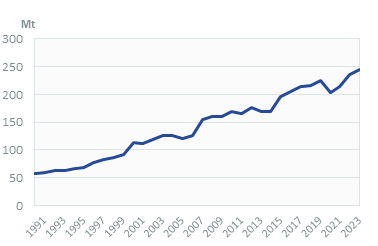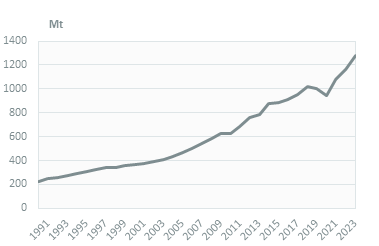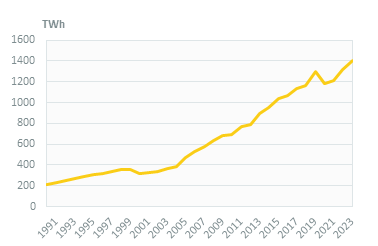-
-
 Energy and Climate Databases
Energy and Climate Databases- The most comprehensive and up-to-date annual energy database.
- Monitoring of technology providers in H2 supply chain.
- Monthly energy data on key energy markets.
- The most reliable and up-to-date power generation database.
- The essentials of LNG trade at your fingertips.
- Global monitoring of new and existing refineries.
- Analyse energy consumption and efficiency trends at world level. Benchmark countries.
- Have your database developed by a recognised expert of both energy and IT.
-
 Energy - Climate Forecasts
Energy - Climate Forecasts- Instant access to energy and emissions forecasts.
- Strategic, annual wholesale price projections backed by Enerdata's energy modelling expertise and our globally recognised POLES model.
- Wedges module showing a breakdown of the levers enabling to reduce emissions between two scenarios.
- Unique, independent projections of consumption by end-use.
- GHG Marginal Abatement Cost Curves.
- Benefit from proven models to draw your own energy scenarios and anticipate tomorrow’s challenges.
-
 Market Intelligence
Market Intelligence- 110 Energy and climate country reports
- A newsletter to receive the latest updates on evolving technologies and policies.
- Global energy news and analyses curated daily.
- Enerdata’s experts bring you the essentials about your market and competitors.
-
-
-
 Market Analysis
Market Analysis- Understanding key consumption trends and drivers across sectors.
- Granular and exclusive insight to address the most pressing business and strategic issues.
- Expertise in strategic and business intelligence, with fine-tuning to the market’s specificities.
-
 Energy - Climate Scenarios
Energy - Climate Scenarios- Providing the outlook of an energy commodity in mid to long term time horizons.
- Sector and driver specific energy demand forecasting.
- Assess the evolution of energy prices on the international and regional markets, as well as end-users prices.
- Enerdata guides you through pathways to reach climate targets.
- Supporting local authorities in their decarbonisation strategies.
-
 Climate Strategy and Policy Evaluation
Climate Strategy and Policy Evaluation- Cutting-edge quantitative tools and relevant indicators to monitor and evaluate evolutions on worldwide energy markets.
- Analysis of the most cost-effective options to reduce emissions.
- Quantified simulation and analysis of pledges for climate change negotiations.
- Breakdown and analysis of carbon markets.
- Enerdata guides you on the most beneficial policy or investment options.
- Turning climate objectives into concrete action plans.
-
 Training
Training- Understand different policy targets and measures on energy efficiency.
- How to measure energy savings?
- Energy Forecasting is a 2 days training to learn to design and interpret energy forecasts.
- Energy statistics training allowing to create energy balance with supply, transformation and consumption and understanding the international energy statistics regulations.
- Initiation to EnerMED level 1is the training to approach on the most powerful energy demand forecasting model.
-
-
Resource Centre
India Key Figures
- Population:
- 1429 million
- GDP growth rate:
- 7.83 %/year
- Energy independence:
- 65.8%
Data of the last year available: 2023
- Total consumption/GDP:*
- 76.3 (2005=100)
- CO2 Emissions:
- 2.10 tCO2/capita
- Rate of T&D power losses:
- 19.6%
* at purchasing power parity
View all macro and energy indicators in the India energy report
India Related News
View all news, archive your new and create your own daily newsletters only on your topics/countries of interest with Key Energy Intelligence
India Related Research
Benefit from up to 2 000 up-to-date data series for 186 countries in Global Energy & CO2 data
A data overview is available in the global energy statistics app
Total Energy Consumption
Total energy consumption per capita reached 0.8 toe (2023), half the Asian average. Electricity consumption per capita reached 985 kWh in 2023.
Total energy consumption continued to grow significantly (6.5%/year since 2020, of which 5% in 2023), reaching 1.14 Gtoe in 2023. It had increased less rapidly over 2010-2023 (4.3%/year).
Coal is the country's top energy source with an increasing share of 49% in 2023 (+9 points since 2010 and +4 since 2020), followed by oil (22%) and biomass (20%). Natural gas covers 5% and primary electricity (hydro, nuclear, solar, and wind) 4%.
Interactive Chart India Total Energy Consumption
Benefit from up to 2 000 up-to-date data series for 186 countries in Global Energy & CO2 data
View the detailed fondamentals of the market at country level (graphs, tables, analysis) in the India energy report
Crude Oil Production
Oil production has declined by 21% since 2010, reaching 33 Mt in 2023 (-10% since 2019).
India is the world's third largest importer of crude oil, reaching its highest level in 2023 at 234 Mt (+2.8%/year since 2010). In 2023, crude oil imports represented 93% of the country's oil needs. The country is a net oil product exporter (18 Mt in 2023), although its net exports have fallen by 40% since 2018.
Interactive Chart India Crude Oil Production
Benefit from up to 2 000 up-to-date data series for 186 countries in Global Energy & CO2 data
Additionally, for more detailed information on refineries, you can request a sample of our Asia Refineries Dataset
Oil Products Consumption
Oil product consumption has rebounded since 2020 (7%/year) after a sharp drop in 2020 (-10%) and reached 245 Mt in 2023. It had increased less rapidly over 2010-2019 (3%/year).
Of the total consumption for 2023, 53% was used in transport, 19% in industry (including non-energy uses), and 14% in the residential, services, and agriculture sector.
Graph: OIL CONSUMPTION (Mt)

Graph: OIL CONSUMPTION BREAKDOWN BY SECTOR (2023, %)
Interactive Chart India Refined Oil Products Production
Benefit from up to 2 000 up-to-date data series for 186 countries in Global Energy & CO2 data
Additionally, for more detailed information on refineries, you can request a sample of our Asia Refineries Dataset
Natural Gas Consumption
Gas consumption increased by 11% to 70 bcm in 2023, after a 7% decline in 2022 as high gas prices deterred imports. Between 2014 and 2023, gas consumption increased by 3.3%/year.
Industry is the main consumer of gas with 36% in 2023 (mainly fertiliser plants). It is followed by electricity production (20%) and transport (19%). The residential and services sector accounted for 2%; the actual share of this sector is underestimated as official statistics combine transport (CNG) and sales of city gas to local distributors, mainly in residential and services.
Interactive Chart India Natural Gas Domestic Consumption
Benefit from up to 2 000 up-to-date data series for 186 countries in Global Energy & CO2 data
Additionally, for more detailed information on the LNG trade, you can request a sample of our Asia LNG Trade Dataset
Coal Consumption
Coal and lignite consumption has increased very rapidly since 2020 (11%/year) reaching 1.3 Gt in 2023. Between 2015 and 2018, the progression was twice slower (around 5%/year). The consumption decreased in 2019 and 2020.
In 2023, power generation and industry were the main consumers of coal and lignite, with 62% and 34%, respectively.
Graph: COAL CONSUMPTION (Mt)

Graph: COAL CONSUMPTION BREAKDOWN BY SECTOR (2023, %)
Interactive Chart India Coal and Lignite Domestic Consumption
Benefit from up to 2 000 up-to-date data series for 186 countries in Global Energy & CO2 data
View the detailed consumption trends at country level (graphs, tables, analysis) in the India energy report
Power Consumption
Electricity consumption increased by 6%/year since 2020, of which 6.5% in 2023 to 1407 TWh. It also grew rapidly over 2010-2019 (7%/year) and fell by 8.5% in 2020.
Graph: ELECTRICITY CONSUMPTION (TWh)

Renewable in % Electricity Production
IREDA, the Indian Renewable Energy Development Agency, finances the development of renewables.
SECI, Solar Energy Corporation of India, under the MNRE, manages the implementation of the Jawaharlal Nehru National Solar Mission (JNNSM). The Solar Mission aimed to deploy 100 GW of solar power over 2010-2022 (73 GW in 2023). The government also set the target of 40 GW of rooftop solar capacity by mid-2022 (only 10 GW installed at the end of 2023). A new subsidy scheme for rooftop solar was released in April 2024 to meet the target by 2026.
Interactive Chart India Share of Renewables in Electricity Production (incl hydro)
Benefit from up to 2 000 up-to-date data series for 186 countries in Global Energy & CO2 data
Learn more about renewables in the Mini grid Africa & Asia markets for village electrification
CO2 Fuel Combustion/CO2 Emissions
In its updated NDC (2022), the country reiterated a target to reduce its CO2 emission intensity of GDP by 45% in 2030, compared to 2005 levels. In 2021, the country pledged to reach net-zero emissions in 2070.
The country does not publish GHG emissions inventories. According to Climate Transparency, India's emissions (excl. LULUCF) increased by 182% between 1990-2019 to 3.26 GtCO2e (of which 73% from the energy sector, 15% from agriculture, 9% from industrial processes and 3% from waste).